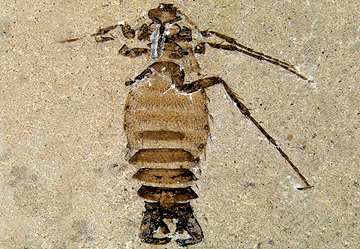Abstract
The Mesozoic ‘anisozygopteran’ clade Isophlebiida Bechly, 1996 is quite diverse with more than 48 described genera, especially in the two families Campterophlebiidae Handlirsch, 1920 and Isophlebiidae Handlirsch, 1906, in which numerous new genera have been recently described mainly from China (see Fossilworks: Gateway to the Paleobiology Database at http://fossilworks.org/). However, this is not the case for the more inclusive isophlebiopteran clades Euthemistidae Pritykina, 1968, Parazygoptera Bechly, 1997, and Selenothemistidae Handlirsch, 1939, that comprise ca. 25 described genera. These last groups comprise relatively small and delicate damsel-dragonflies, compared to the Isophlebiida. Thus, their lower diversity is possibly a result of taphonomic bias. They are mainly known from Europe, Central Asia and China.
References
Bechly, G. (1996) Morphologische Untersuchungen am Flügelgeäder der rezenten Libellen und deren Stammgruppenvertreter (Insecta; Pterygota; Odonata), unter besonderer Berücksichtigung der Phylogenetischen Systematik und des Grundplanes der Odonata. Petalura, Special Volume 2, 1–402.
Bechly, G. (1997) New fossil Odonata from the Upper Triassic of Italy, with a redescription of Italophlebia gervasutti, and a reclassification of Triassic dragonflies. Rivista del Museo Civico di Scienze Naturale E. Caffi, 19, 31–70.
Bechly, G. (2016) Phylogenetic systematics of Odonata. Available from: https://dl.dropboxusercontent.com/u/13756162/Website/odonata/system.htm (Accessed 17 Dec. 2018)
Cowley, J. (1942) Descriptions of some genera of fossil Odonata. Proceedings of the Royal Entomological Society of London, (B), 11, 63–78.
https://doi.org/10.1111/j.1365-3113.1942.tb00725.x
Deng, S., Yao, Y., Ye, D., Chen, P., Jin, F., Zhang, Y., Xu, K., Zhao, Y., Yuan, X. & Zhang, S. (2003) The Jurassic System of North China (I): A stratigraphic Overview. Petroleum Industry Press, Beijing, 399 pp.
Garrouste, R. & Nel, A. (2015) New Eocene damselflies and first Cenozoic damsel-dragonfly of the isophlebiopteran lineage (Insecta: Odonata). Zootaxa, 4028 (3), 354–366.
https://doi.org/10.11646/zootaxa.4028.3.2
Hong, Y.-C. (1983) Middle Jurassic fossil insects in North China. Geological Publishing House, Beijing, 223 pp. [in Chinese with English summary]
Huang, D.-Y. (2015) Yangliao biota and Yanshan movement. Acta Palaeontologica Sinica, 54, 501–546. [in Chinese with English summary]
Huang, D.-Y. (2016) Daohugou Biota. Shanghai Scientific & Technical Publishers, Shanghai, 332 pp.
Huang, D.-Y. (2018) Jurassic integrative stratigraphy and timescale of China. Science in China: Earth Science.
https://doi.org/10.1007/s11430-017-9268-7
Huang, D.-Y., Cai, C.-Y. & Nel, A. (2018) A new damsel-dragonfly of the small family Selenothemistidae from the Late Jurassic of China (Odonata: Isophlebioptera). Journal of Paleontology, 92, 1049–1053.
https://doi.org/10.1017/jpa.2018.33
Jacquelin, L., Desutter-Grandcolas, L., Chintauan-Marquier, I., Boistel, R., Zheng, D.-R., Prokop, J. & Nel, A. (2018) New insights on basivenal sclerites using 3D tools and homology of wing veins in Odonatoptera (Insecta). Scientific Reports, 8, 1–7.
https://doi.org/10.1038/s41598-017-18615-0
Kelly, R.S. & Nel, A. (2018) Revision of some damsel-dragonflies (Odonata, Liassophlebiidae and Anglophlebiidae new family) from the Triassic/Jurassic of England and Antarctica. Journal of Paleontology, 92, 1035–1048.
https://doi.org/10.1017/jpa.2018.32
Nel, A., Martínez-Delclòs, X., Paicheler, J.C. & Henrotay, M. (1993) Les ‘Anisozygoptera’ fossiles. Phylogénie et classification (Odonata). Martinia Numéro Hors Série, 3, 1–311.
Pritykina, L.N. (1968) Strekozy Karatau (Odonata). [Dragonflies from Karatau (Odonata)]. In: Panfilov, D.V. (coord.), Yurskie Nasekomye Karatau. [Fossil insects from Karatau]. Academy of Sciences of the S.S.S.R., Nauka, Moscow, pp. 26–55. [in Russian]
Pritykina, L.N. (1980) New fossil Odonata from the Mesozoic of Central Asia. In: Dolin, V.G., Panfilov, D.V., Ponomarenko, A.G. & Pritykina, L.N. [Mesozoic fossil insects.] Naukova Dumka, Kiev, pp. 119–131. [In Russian]
Riek, E.F. & Kukalová-Peck, J. (1984) A new interpretation of dragonfly wing venation based upon Early Carboniferous fossils from Argentina (Insecta: Odonatoidea) and basic characters states in pterygote wings. Canadian Journal of Zoology, 62, 1150–1166.
https://doi.org/10.1139/z84-166

